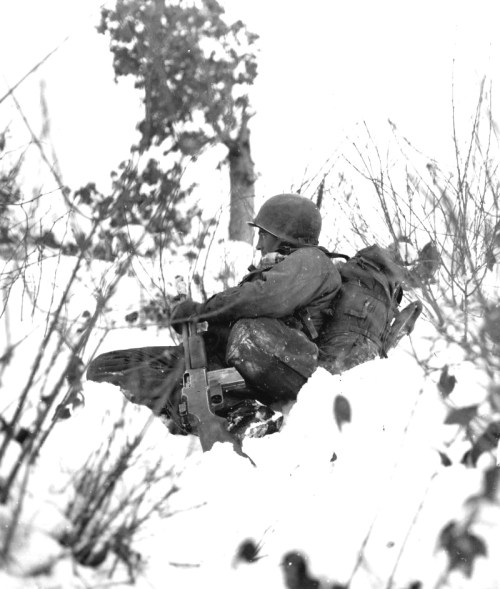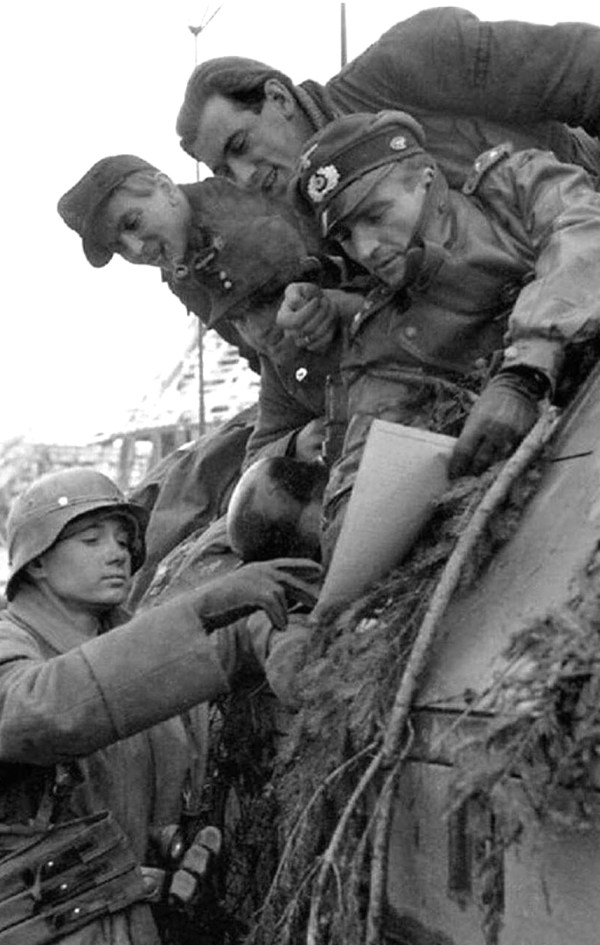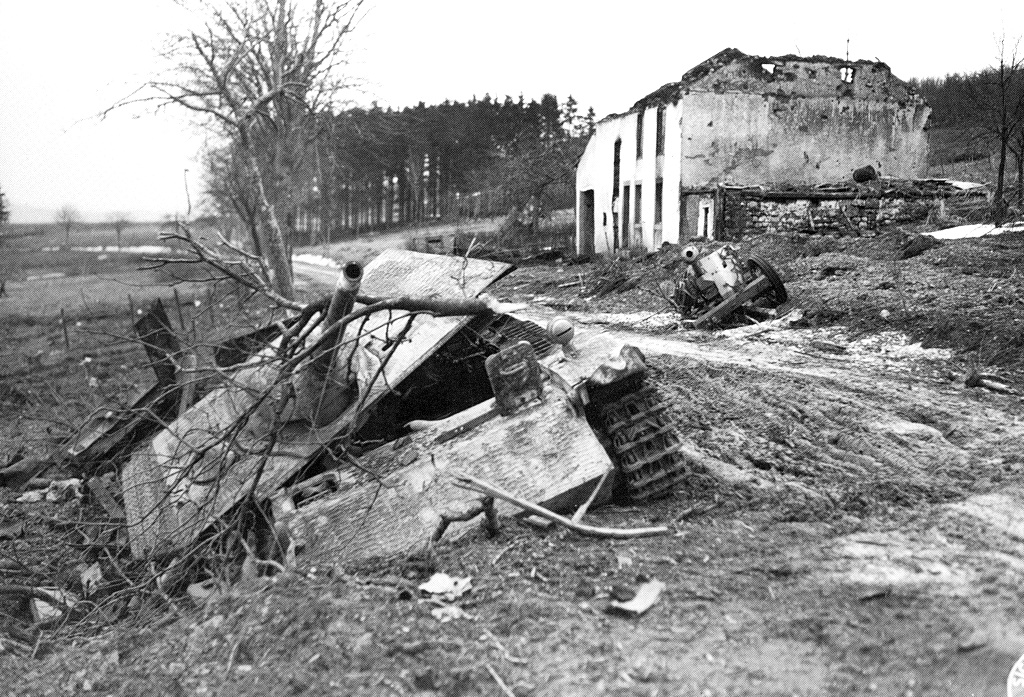Document Source: Operations Report of the 1st Battalion, 110th Infantry Regiment, 28th Infantry Division in the vicinity of Heinerscheid and Marnach during the Batte of the Bulge, Grand Duchy of Luxembourg, December 16 to December 18, 1944, Personal Experience of Capt David B, Wright, Battalion Operations Officer.
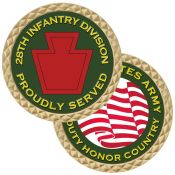 After continuous fierce fighting, the US 1-A, initiated the breakout at St Lô, France, which was accomplished just forty-nine days after the assault troops landed on the beaches of Normandy. The success of this breakout surpassed the wildest expectations of the Allied military leaders. After running rampant over France, Belgium, and Luxembourg, on September 11, 1944, the advance elements of the 1-A crossed the border of Germany. In spite of the fact that this penetration was a major victory, numerous difficulties were encountered, one of which was the long supply lines that were stretched almost to the breaking point. In addition, the troops were very tired as they had been attacking continuously for over three months. Therefore the advance came to a halt before the fortifications of Germany, known as the West Wall (Siegfried Line).
After continuous fierce fighting, the US 1-A, initiated the breakout at St Lô, France, which was accomplished just forty-nine days after the assault troops landed on the beaches of Normandy. The success of this breakout surpassed the wildest expectations of the Allied military leaders. After running rampant over France, Belgium, and Luxembourg, on September 11, 1944, the advance elements of the 1-A crossed the border of Germany. In spite of the fact that this penetration was a major victory, numerous difficulties were encountered, one of which was the long supply lines that were stretched almost to the breaking point. In addition, the troops were very tired as they had been attacking continuously for over three months. Therefore the advance came to a halt before the fortifications of Germany, known as the West Wall (Siegfried Line).

 In order to continue the attack on the German defenses it was necessary to concentrate most of the available forces in the areas in which the offensive was to take place. Other sectors of the front were lightly defended. In the 1-A’s area, the Ardennes sector, held by the VIII Corps, was selected as the sector to be lightly manned, while the 1-A offensive was to be made to the north to capture Düren, reach the Rhine River and take Cologne.
In order to continue the attack on the German defenses it was necessary to concentrate most of the available forces in the areas in which the offensive was to take place. Other sectors of the front were lightly defended. In the 1-A’s area, the Ardennes sector, held by the VIII Corps, was selected as the sector to be lightly manned, while the 1-A offensive was to be made to the north to capture Düren, reach the Rhine River and take Cologne.

 On November 20, 1944, the 28-ID, composed of the 109, 110, and 112-IRs, completed the exchange of sectors with the 8-ID, was relieved from the V Corps, and assigned to the VIII Corps, a part of the US 1-A. The main north-south road in the area, designated the Red Ball Highway, was about one mile west of the Our River, facing the Siegfried Line. The 28-ID was in a position generally parallel with this road. Due to the excessive frontage of this sector, 25 miles, all three regiments were online. The 112-IR on the north and the 109-IR on the south.
On November 20, 1944, the 28-ID, composed of the 109, 110, and 112-IRs, completed the exchange of sectors with the 8-ID, was relieved from the V Corps, and assigned to the VIII Corps, a part of the US 1-A. The main north-south road in the area, designated the Red Ball Highway, was about one mile west of the Our River, facing the Siegfried Line. The 28-ID was in a position generally parallel with this road. Due to the excessive frontage of this sector, 25 miles, all three regiments were online. The 112-IR on the north and the 109-IR on the south.
110th Infantry Regiment
On December 1, the 110-IR with the 32-CRS the 109-FAB the 687-FAB, Baker Co, and two Recon Platoons of the 630-TDB attached, occupied the center of the division sector. The regimental front extended from Kalborn on the north to Bastendorf on the south, a distance of approximately fifteen miles. The regiment was disposed of approximately a mile west of and parallel to the Our River. The 32-CRS on the north, the 2/110 on the south, with the 1/110 in mobile division reserve in Feuhren, Luxembourg.
From November 16 to December 2, the 1st Battalion of the 110th Infantry Regiment, in the division reserve, initiated a program of intensive training and rehabilitation. This training period included a problem that consisted of moving a battalion tactically across wooded terrain. This problem was particularly appropriate due to the fact that the battalion had just experienced the worst type of winter warfare in the dense Hürtgen Forest, suffering approximately 80% casualties as a result of both enemy actions and the elements. It was felt that the replacements who had joined the unit upon its relief from the V Corps to the north, would benefit materially from this problem in view of the fact that additional combat of this type was imminent. Replacements included the battalion commander and three rifle company commanders.
On December 9, the 2/110 relieved the 32-CRS in the northern portion of the regimental sector. The area previously held by the 2/110 was taken over by the 109-IR. On this date, the cavalry unit reverted to its parent organization. On December 10, the 1/110 relieved the 2/110 which became the division reserve. The 1/110 then began to carry out its part of the regimental mission, which was in effect, to patrol the sector and keep the enemy east of the Our River.
The battalion front at this time extended from a road junction 2000 yards north of Heinerscheid, to and including, Marbourg on the south, a distance of approximately ten miles. The plan of operation of the battalion was one of offensive-defensive, consisting of company strong points from which patrols would operate. It was to have units varying in platoon strength occupying villages along the Red Ball Highway, with outposts of squad size on the Our River. These outposts were equipped with SCR-300 radios which were netted with the companies. In addition, wire lines were constructed for telephone communication. Patrols were to operate between the company’s strong points and smaller units along the highway. The area in which the patrolling was to be conducted had been extensively booby-trapped by a unit previously occupying the area. No record of the location of these booby traps was given to the battalion, consequently several of the patrols suffered casualties.
On December 15, the 1/110 was disposed along the Red Ball Highway from the north to the south and as follows: Able Co, Heinerscheid; 1 plat. at a road junction 2000 yards north of Heinercheid; 1 squad at Kalborn; 1 squad at Fischbach; Baker Co in Marnach; 1 plat. at Reuler; 1 squad at Marbourg and Charlie Co in battalion reserve at Reuler conducting training. The battalion plan was to rotate the line units so that each company would have an opportunity to continue the training that was begun in November. The remainders were located as follows: Dog Co in Grindhausen; 1 section (81-MM) Mortar plat. at Marnach, attached to Baker Co, 1 section of the (81-MM) Mortar Plat.
At Heinerscheid and attached to Able Co and the remaining section was to be at Grindhausen. One machine-gun plat. of Dog Co was attached to Able Co and one to Baker Co. The Battalion HQs Company and the Battalion CP were in Ursphelt. One section of 57-MM AT guns from the Battalion AT Plat. was employed on the road between Marnach and Dasburg. The second section was at Heinerscheid covering the roads to the east and north.
The German Flaw off Attack
Hitler had concluded that in order to maintain the morale of the German troops, it was necessary to resume the offensive. The principal question was where could this offensive best be launched. After a thorough study of all combat areas, the western front was selected. Then after further study, it was decided that the lightly manned Belgian Ardennes sector was the area in which this offensive was most likely to succeed. This area was not new to the Germans as they had successfully attacked here on three previous occasions. First in 1870, then in 1914, and more recently in 1940 during the height of the German Blitzkrieg. The overall plan of the German High Command was to employ three armies to cross the Meuse River, and capture Bruxelles and Antwerp. Dietrich’s 6.SS-Panzer-Army on the north was to reduce Liège and Antwerp. Manteuffel’s 5.Panzer-Army in the center attacked toward Namur and on to seize Bruxelles while Brandenberg’s 7.Army on the south would be employed in a diversionary attack to seize Luxembourg and block any force to the south. The German commander assumed that this attack would trap from twenty to thirty US divisions, which in turn would deal a devastating blow to the American forces as there were less than fifty divisions in Europe at this time.
The German counter-offensive was launched at 0530, December 16, 1944, as out of the cold, overcast sky came the German artillery while simultaneously over the equally cold, snow-covered ground the German infantry and tanks attacked. The Battle of the Bulge had begun.
The Terrain
In the sector of the 1/110, the terrain was a series of ridges and valleys running parallel with the front. These terrain features formed several cross compartments. The Our River was a narrow stream that ran north and south. The terrain sloped gently upward for about a mile west forming a ridge parallel to the river. This ridge was the route of the main north-south road, an excellent all-purpose road previously referred to as the Red Ball Highway. All along this road were villages and towns. The ridge fell off gently to the west forming another valley. From the Our River, west, the ridges and valleys were heavily wooded with the exception of the villages and several fields. The main east-west road connected Marnach and Dasburg. There were secondary roads running east from Heinerscheid, Grindhausen, and Fischbach. This was the Ardenne Forest.
On December 15, the Intelligence Report received by the S-2 1/110, stated that the enemy capabilities were to defend in present positions and to make small-scale raids across the Our River. Early after dark during the night of December 15-16, outposts and patrols from Baker 110, operating near the Our River east of Marnach, reported the movement of armor across the River. However, after these initial reports, all further reports were negative. Nothing unusual was happening in the area.
At 0545, December 16, the entire battalion front was subjected to a very heavy artillery barrage. The barrage continued until 0630, decreased in intensity for a short period, and then became more intense at 0700. At 0730 the artillery lifted from the completely dazed battalion. Wire communication was out from the Battalion CP to all three rifle companies. However, the battalion radio nets were operating efficiently. All the units of the battalion had been hard hit by the artillery, which seemed to search our CPs with uncanny ability. Able Co, at Heinerscheid reported that it had received heavy artillery concentrations but that there was no sign of an attack on their position by infantry. Elements of Able Co, at Fischbach and at the Roads Junction to the north reported the situation unchanged. Baker 110, at Marnach, was especially hard hit. Many of the buildings were destroyed and the town was a mass of wreckage. The platoon of Baker at Reuler and the squad at Marbourg were also heavily shelled. The Battalion HQs Co and the Battalion CP at Ursphelt were also shelled. However, there were no casualties.
At 0730 the platoon of Baker at Reuler was attacked by an enemy force estimated at one battalion, necessitating the withdrawal of the platoon to Marnach. The attack continued and as the enemy advanced over the open ground to the east of the town, Baker Co and its attached and supporting weapons opened fire inflicting very heavy casualties on the attacking force. The Germans were disorganized and withdrew. The battalion situation was reported to the regiment and the order received from the regiment was: Hold At All Costs! At 0830, Able Co was attacked by enemy infantry and tanks. This attack was broken up by the company. The AT Platoon’s 57-MM guns knocked out two of the hostile tanks. The CO reported that infantry was bypassing Heinerscheid to the north and to the south, and asked permission to return the plat. at the road junction to the company, area to strengthen his position and to keep the plat. from being completely cut off. The CO refused this request. At 1130, Able Co’s CO reported that his position was surrounded and again requested permission to bring the platoon to Heinerscheid.
He stated that his position was under fire but that the company was not being attacked at the moment but apparently the enemy was keeping him under fire to prevent him from interfering with the movements of troops to the north and south. He also reported tanks in the area and requested tank support. He stated that possibly with tanks he could stop the movement of the enemy to his north. The Battalion CO again refused to grant permission to move the platoon. He did, however, request tanks from the regiment. At 1300, the entire battalion front again was attacked. Baker Co at Marnach was attacked by infantry supported by tanks. This assault succeeded in penetrating Marnach and the company was forced to execute a delaying action from house to house. In several instances, fighting took place from floor to floor. Charlie Co was committed to retaking this town supported by a platoon of medium tanks from Baker 707-TB which had been attached in response to the request of the Battalion CO.
The plan for this attack was for Charlie Co to move east from Reuler on the Clerf – Marnach road to a road that ran southeast, proceed on this road to the Marnach – Munchausen road, attack up this road to Marnach. At the same time, eight light tanks of the 707-TB were to attack south from Fischbach on the Red Ball Highway and strike the enemy on his flank from the north.
Charlie Co moved out of Reuler at 1330 and as it reached the road that connected the Marnach – Munchausen road they were subjected to heavy mortar and small arms fire from the woods to the south. This fire wounded the CO and either wounded or killed all except one of the officers of the company. Charlie Co was completely disorganized, but under the one remaining officer deployed north of the Clerf – Marnach road. The medium tanks opened fire with their 76.2-MM (3′) and machine gun and the enemy withdrew. The Battalion S-3 organized the remnants of the company, which consisted of about one and one-half platoons, and moved east on the Clerf – Marnach road, preceded by the medium tanks and entered Marnach at approximately 1730. When Charlie Co and the tanks entered Marnach the enemy withdrew.
During the engagement, Baker Co captured thirty prisoners. The light tanks reached Fischbach and started south on the Red Ball Highway. They were just south of Fischbach when they encountered fire from enemy infantry using their Panzerfaust (AT Rocket), the German equivalent of our Bazooka. This fire stopped the advance of the light tanks and only two of them got away. These two came back to Ursphelt and went in a position to protect the Battalion CP. At 1430, a platoon of medium tanks from the 707-TB was sent to Heinerscheid to relieve the pressure on Able Co which was now being attacked vigorously.
These tanks reached Heinerscheid but upon entering the town were taken under fire by several German Mark V Panthers. In this action two of the friendly tanks were disabled. At about 1630, a platoon leader of Baker 630-TDB reported that a battery of the 109-FAB in Hupperdange had been overrun. He had been able to withdraw a section of his three-inch guns from the town and had gone into position on the high ground on the south edge of Ursphelt where he could cover the draw to the east and northeast. The Ammunition and Engineers Platoon prepared positions on the east of Ursphelt.
During the night of December 16-17, the enemy sent patrols into Marnach and Heinerscheid but when fired on withdrew. These patrols harassed the Battalion continuously throughout the night. At 0800, December 17, the Battalion did not have contact with Baker 110 and Charlie 110 at Marnach or with Able 110 at Heinerscheid. The Battalion S-2, S-4, and the Battalion AT Platoon leader went to Hupperdange and recovered a 105-MM Howitzer and a truckload of ammunition returning both to Ursphelt. This gun and ammunition had been abandoned by the artillery unit when it was overrun on December 16. The gun was put in position so it could cover the draw to the east. The Battalion was no longer operating as a unit but was now fighting as small individual groups that were separated and surrounded. The Battalion did not have contact with either of the units on the right or left. Neither did elements of the Battalion have contact with each other, all wires having been severed and the batteries of the radios exhausted.
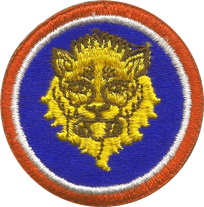 The 109-IR of the south was holding at Diekirch but their left flank had fallen back leaving the right flank of the 110-IR completely exposed.
The 109-IR of the south was holding at Diekirch but their left flank had fallen back leaving the right flank of the 110-IR completely exposed.
The 112-IR on the left flank pulled back and was attached to the 106-ID (424-IR) leaving the left flank open. The enemy attacked Ursphelt at 1100 on December 17 with Infantry and tanks, advancing up the draw and through the woods to the east. All available artillery fire was placed on this route of advance. The section of guns of Baker 630-TDB knocked out eight of the hostile tanks. The 105-MM Howitzer maned by the Battalion S-2, the S-4, the Battalion AT Platoon leader, and the two light tanks fired direct fire into the advancing infantry. The Ammunition and Engineer Platoon opened fire with small arms when the enemy was within 200 yards of their position. Under this fire, the enemy was disorganized and began to withdraw. During their withdrawal, the fire of friendly riflemen and artillery inflicted very heavy casualties on the hostile force. No enemy succeeded in penetrating the village in this attack, and the only casualty suffered by the force at Ursphelt was the loss of one of the light tanks which suffered a direct hit from a German tank. The little force checked its ammunition and prepared for another attack. The ammunition was alarmingly short. They did not have long to wait as the Germans attacked again at 1600.
This assault was met by the fire of every weapon in the village. The enemy continued the attack and by 1700 succeeded in taking Ursphelt. The group withdrew toward Clerf, which was the Regimental CP, and at 1800 the Battalion S-3, the S-2 and about twenty men entered the town. The men went into position with the force defending the town while the S-2 and the S-3 reported to the Regimental Commander. Although surrounded and under a heavy tank, artillery, mortar, and small arms fire, the 1/110 continued to fight in scattered groups, until late on December 18 and then with ammunition gone, approximately fifty survivors of the Battalion succeeded in getting through the enemy lines to the rear. The 1/110-28-ID was a unit in name only.

